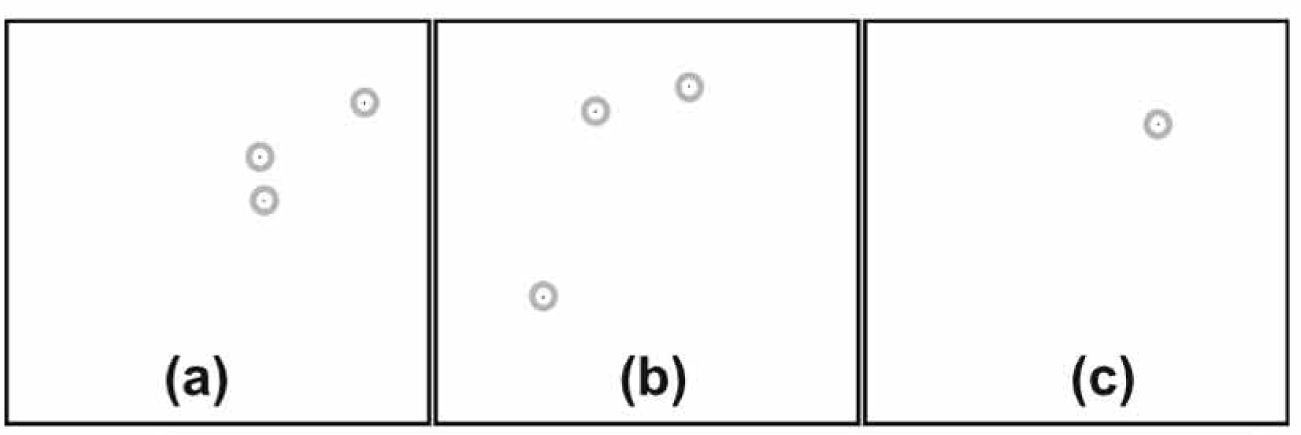X-RAY RUNS: Apply for Beamtime
2017 Nov 1 - Dec 21
2018 Feb 7 - Apr 3
2018 Proposal/BTR deadline: 12/1/17
2018 Apr 11 - Jun 4
2018 Proposal/BTR deadline: 2/1/18
Imagine recording a photograph with shorter and shorter exposures. Even with a noiseless camera, the image will eventually become grainy because of the random arrival of photons within the exposure period. If the exposure is so brief that only 2 or 3 photons are recorded, the image will consist of a few apparently randomly dots (Fig 1). Nevertheless, if the camera is sufficiently noiseless, it is clear that the addition of many thousands of such random images will still reproduce the photo.

(Fig 1) Severely noise limited images. Although each image consists of almost 40,000 pixels, each consist of only a few recorded photons (circles dots) (From [1]). With so few photons, it is difficult to determine what object this is an image of, much less the orientation of the imaged object.
What if the images were of an object rotating on a turntable? And, further, that the orientation of the object when each photograph was recorded is unknown? In this case, it seems a hopeless task to reconstruct an image of the object. Remarkably, as recently experimentally demonstrated by Philipp et al. [1], this is not the case. Using an expectation maximization approach devised by Elser and his students [2, 3], Phillipp et al. [1] demonstrated experimentally that the collection of severely noise-limited images does contain enough information to reconstruct an accurate representation of the original object. The work involved personnel and detector capabilities at CHESS.
The problem of adding many severely noise-limited images of unknown orientation is precisely the problem encountered in proposed X-ray Free Electron Laser (XFEL) experiments to blast many copies of a protein, one at a time, with pulses from the XFEL beam [4] to determine the structure of the protein. The orientation of protein is unknown when it is hit by the few femtoseconds long XFEL pulse, and too few x-rays are scattered to determine the orientation of the molecule. The fact that the scattered x-rays are related to the electron density of the protein and that the molecular orientation is unknown in 3-space (i.e., around two axes, not just one, as in the turntable example) is readily accommodated the expectation maximization approach devised by Elser and co-workers. As far as the approach and the x-ray detector are concerned, the experiment samples a severely noise-limited photon field that differs from one image to another simply by a rotation, just like the photo example given above.
Philipp et al. [1] have now proven that the approach works in a real experiment with real data. The experiment involved imaging an x-radiograph (Fig 2) of a rotating object cut from a sheet of lead foil. The incident x-ray intensity was turned down so that an only 2.5 x-rays were recorded, on average, per image (Fig 1). The x-ray detector chip was the same type installed at the SLAC XFEL [5]. A movie of the reconstruction in action may be seen at Optics Express web-site [http://www.opticsinfobase.org/oe/fulltext.cfm?uri=oe-20-12-13129&id=234556].

(Fig 2) (a) An object cut from x-ray-opaque lead foil as mounted in the aperture of a rotating stage. (b) An x-radiograph of the object while stationary. (c & d) Reconstructed radiographs of the object from severely noise-limited images. The average number of recorded x-rays per image were 11.5 and 2.5 in (c) and (d), respectively. Fig. 1 shows some representative images used to reconstruct (d).
Significantly, the experiment illustrates a general approach, and was performed with a low-power x-ray source. The reason this is important is that XFEL availability will be very limited for many years. One can imagine analogous experiments, such as diffraction from protein nanocrystals, at more readily available synchrotron x-ray storage ring ports.
Reference:
[1]
H.T. Philipp, K. Ayyer, M.W. Tate, V. Elser, and S.M. Gruner; “Solving
Structure with Sparse, Randomly-oriented X-ray Data”, Optics Express, 20, 13129 (2012)
[2] V. Elser; “Noise Limits on Reconstructing Diffraction Signals from Random Tomographs”, IEEE Trans. Inf. Theory 55, 4715–4722 (2009)
[3] N.-T. D. Loh, and V. Elser; “Reconstruction Algorithm for Single-particle Diffraction Imaging Experiments”, Phys. Rev. E 80, 026705 (2009)
[4] R. Neutze, R. Wouts, D. van der Spoel, E. Weckert, and J. Hajdu, “Potential for Biomolecular Imaging with Femtosecond X-ray Pulses”; Nature 406, 752–757 (2000)
[5] H.T. Philipp, L.J. Koerner, M.S. Hromalik, M.W. Tate, and S.M. Gruner; “Femtosecond Radiation Experiment Detector for X-ray Free-electron Laser (XFEL) Coherent X-ray Imaging”, IEEE Trans. Nucl. Sci. 57, 3795–3799 (2010)
Submitted by: Arthur Woll, CHESS, Cornell University
8/1/2012
